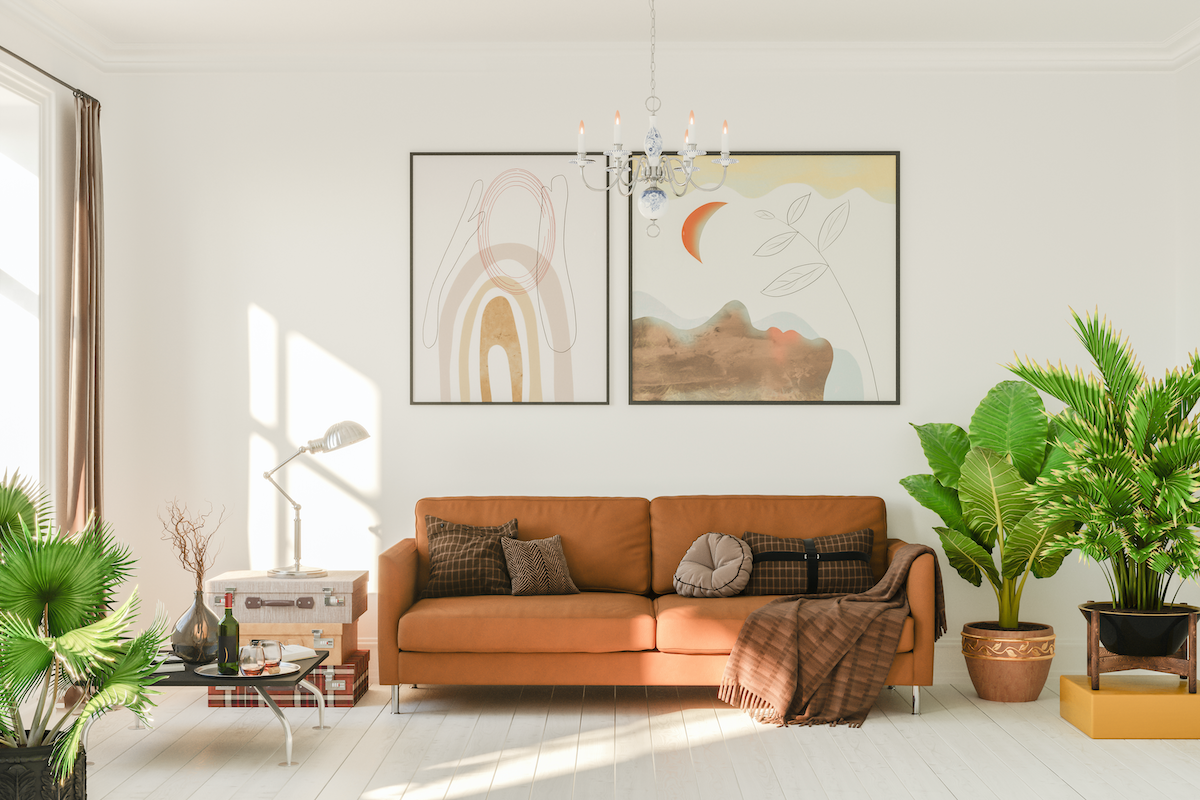A newbie’s guide to mid-century modern in your home

Mid-century modern decor first arose in the late 1940s, right after World War II. Its modern visuals, sleek lines, vibrant colors, and nods to everything space-age was more than just a new design style — it was hope for the future represented through home decor. Much of the world had just gone through the challenges of war, and was yearning for something fresh and encouraging. In its own way, mid-century decor answered that call.
While interior design certainly won’t save the world, it can make us feel more joyful. Little acts of bettering our homes have proven to be a healing salve throughout these tough times, and decorating does its part to help us feel like we’re in control of our own little universes.
If you’ve been thinking about starting to collect bits of mid-century decor of your own, now’s as good a time as any — our collective love for mid-mod style shows no signs of fading out. Don’t worry — tour entire house doesn’t have to be an homage to the 1950s. Instead, you can start small and build from there (think: a single light fixture instead of an entire living room filled with mid-century furniture).
For some truly special mid-mod inspo, these tips from five top mid-century experts will start you on your way. Good vibes and mid-century decor — here we come.
Do your homework
“If you want to start collecting any kind of authentic vintage decor, you need to be educated so that you can spot the good stuff and not overpay,” says designer Emily Henderson. She recommends going on websites like Chairish or 1stDibs to start learning about names and prices and scoping out what you actually might want to look for — and own.
There are several mid-century buzzwords you can learn about and locate during your quests. For example, Audrey McGill, who has dressed up her 1960s home in authentic mid-mod finds, shares that Charles and Ray Eames are particularly iconic designers. She says, “Designed in 1956, their Eames lounge chair is one of the most recognizable pieces of the mid-century era. Its design was considered groundbreaking and has been replicated many times over.”
She adds that Danish Modern is a particular style of note from this era, known for its sleek, minimal lines along with quality materials. “The use of teak was quite popular, as well as oak,” she says.
McGill says that Hans Wegner, known for the “Papa Bear” and “Wishbone” chairs, and Arne Jacobsen, famous for the Egg and Swan chairs, are just a couple notable Danish Modern designers to be aware of. If you really want to go for broke while seeking out mid-century finds, research the time period (from 1945 to 1969) and learn more about the designers and specific design movements associated with that period.
Don’t count out thrift shops
Contrary to what you may have heard, mid-century pieces aren’t always expensive. In fact, you might be able to score some amazing pieces at the Goodwill down the street.
“The great thing about vintage mid-century pieces is that they are pretty easy to find at many vintage shops, flea markets, or even at Goodwill,” says Dabito, designer and creative director of Old Brand New. “Before I embarked in a career in interior design, I started thrifting and found a variety of chairs and lamp options. They’re some of the easiest ways to incorporate mid-century decor into a space.”
While you can certainly buy whatever you’re drawn to, if you want to get serious, Carrie Waller, founder of the lifestyle and DIY blog Dream Green DIY, recommends looking for original labels.
She says, “Always look inside the drawers or on the underside of tables and chairs to see if you can find an original brand stamp or label. This should provide you with an authentic maker’s mark and date of production.”
Be a vigilant online shopper
Some of the best mid-century treasures around can be found online, through Facebook Marketplace, Etsy, Craigslist, and curated spots like Chairish.
Noel Fahden is the VP of Merchandising at Chairish and says that it’s very important to pay attention to the descriptions of the items.
“When a description says, ‘in the style of,’ that can mean a number of things,” she says. “It can be a modern-day reproduction, or it can be an authentically vintage piece that was made in the style of an iconic design or maker. A vintage ‘in the style of’ piece can still offer great quality at a more approachable price point — it’s really a matter of what provenance and price point you are looking for.”
Also something to keep in mind as you start your quest: There’s a difference between actual vintage and new but reissued (with rights from the original makers) mid-century decor. You can always choose to have a mix of old and new as you build the style into your home.
Fahden also suggests really studying the photos in the listing. Fahden says, “When shopping online, look closely at the images of the item you’re considering. Especially for vintage pieces, minor scratches are part of the aging process and will most likely add character to the piece. When looking at silver or brass decor pieces, aging adds a wonderful patina.”
Start small
Like we mentioned, you don’t have to have a top-to-bottom mid-century living room, complete with a retro sofa and chiminea, to start an authentic MCM collection. We recommend starting with smaller, attainable accessories like ceramics, smaller furniture like shelves, or even a bedside lamp. Fahden agrees that lighting is an ideal starting place.
“A great place to start small with MCM style is with lighting,” Fahden says. “Consider something like a Verner Panton table lamp or a Louis Poulsen PH 5 Mini Pendant to add vibe to your space and personal style without making a huge commitment.”
And finally . . .
Keep in mind that if you aren’t a vintage devotee (which is totally fine) but are still jonesing for some mid-century-like pieces in your home, there are lots of retailers that specialize in brand-new pieces that look exactly like the real deal or hint at bygone design while still looking decidedly contemporary. Burrow’s editor-favorite modular sectionals are a modern interpretation of the era’s clean lines, while Interior Define’s custom upholstery lets you lean into the mid-century vibes as much or as little as you want, and Castlery’s pieces mix mid-century with a bit of coastal flare.


